After WWII, 85% of the Historic Centre of Warsaw was destroyed by nazi-troops: 25% during the Warsaw Ghetto Uprising in 1943, 25% during the Warsaw Uprising in 1944 and 35% after the Warsaw Uprising. The historic centre together with the Royal Castle, houses and churches were destroyed. Warsaw, the capital of Poland, was rebuilt after WWII. The Historic Centre of Warsaw was reconstructed and restored with the preservation of the original fragments of the historic buildings. Some monuments in the Historic Centre of Warsaw are: the statue of the Mermaid of Warsaw in the Market Square, the Rynek Starego Miasta, the Mermaid is the symbol of Warsaw. The Sigismund's Column is a famous and one of the oldest monuments of Warsaw, the column was erected in 1644 in honour of King Sigismund III Vasa, who moved the capital city of Poland from Kraków to Warsaw. The Warsaw Barbican represents the defensive walls and towers that once defended Warsaw, it is the second largest Barbican in Poland, the largest is the Barbican of Kraków . There are numerous churches in Warsaw, one of the most notable is the Baroque Holy Cross Church, the heart of the Polish composer Chopin is interred in a column of the church. The Masterpieces of Frédéric Chopin, the Archive of Warsaw Reconstruction Office, kept in the State Archives of the Capital City of Warsaw, and the Warsaw Ghetto Archives (Emanuel Ringelblum Archives), kept in the Jewish Historical Research Institute in Warsaw, were inscribed on the UNESCO Memory of the World Register. The Historic Centre of Warsaw gained status as a UNESCO World Heritage in 1980.
www.werelderfgoedfotos.nl © Copyright World Heritage Photos Classic Car Road Trip

Historic Centre of Warsaw: The Mermaid of Warsaw. (Polish: Syrenka Warszawska). The statue of the Mermaid of Warsaw is situated in the Rynek Starego Miasta, the Main Market Square, in the historic centre of the Old Town of Warsaw. The mermaid is the symbol of Warsaw. This statue of the Mermaid is a copy. Due to vandalism, the original statue has been removed to the Historical Museum of Warsaw. The Historic Centre of Warsaw became a UNESCO World Heritage in 1980.

Historic Centre of Warsaw: The Mermaid of Warsaw. (Polish: Syrenka Warszawska). The statue of the Mermaid of Warsaw is situated in the Rynek Starego Miasta, the Main Market Square, in the historic centre of the Old Town of Warsaw. The mermaid is the symbol of Warsaw. This statue of the Mermaid is a copy. Due to vandalism, the original statue has been removed to the Historical Museum of Warsaw. The Historic Centre of Warsaw became a UNESCO World Heritage in 1980.
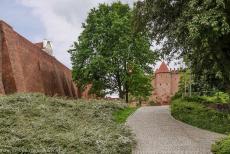
Historic Centre of Warsaw: The Barbican viewed from outside the city walls. The Barbican was a bastion manned by fusiliers, the impressive Barbican was part of the defensive walls and towers that once defended Warsaw. The Barbican was surrounded by a deep, wide moat. The Warsaw Barbican is the second largest barbican in Poland. The largest barbican in Poland is the Kraków Barbican.
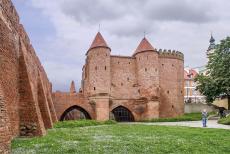
Historic Centre of Warsaw: The original Warsaw Barbican was constructed in the middle of the 16th century. The Barbican represents the defensive walls and towers that once defended the city of Warsaw. The Barbican was almost completely destroyed durring WWII (1939-1945). The Warsaw Barbican was rebuilt in the beginning of the 1950s, on basis of 17th century etchings, it was rebuilt with the preservation of the original fragments.
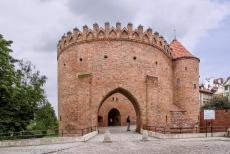
Historic Centre of Warsaw: The huge Warsaw Barbican was built in 1540 on the site of an earlier gate. The Barbican took part in the defence of the city during the Battle of Warsaw in 1656. Not long after it, advances in military history made the Barbican obsolete, it was partially dismantled in the 18th century. The Warsaw Barbican is the second largest barbican in Poland. The Historic Centre of Warsaw was declared a UNESCO World Heritage in 1980.
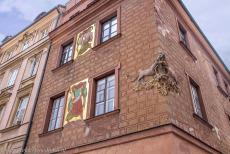
Historic Centre of Warsaw: A house on the Rynek Starego Miasta, the Market Square. The Rynek Starego Miasta was built in the 13th century. During World War II, after the Warsaw Uprising in 1944, the buildings around the square were almost completely destroyed by nazi troops. After WWII, the buildings were restored and rebuilt with the preservation of the original fragments of the historic buildings, they were rebuilt on basis of paintings and photos.
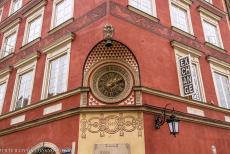
Historic Centre of Warsaw: A decorated clock on the corner of the Simonetti Tenement House. Below the clock is a memorial plaque to commemorate the rebuilding of the historic centre of Warsaw. The Simonetti House is located on the Main Market Square, the Rynek Starego Miasta, in the centre of the Old Town of Warsaw. The Historic Centre of Warsaw was rebuilt by Polish people mainly between the 1950s and the 1970s with the support of the former Soviet Union.
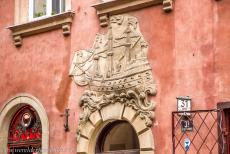
Historic Centre of Warsaw: An early 18th century Rococo ornament depicting a galleon, situated above a portal of a tenement house at Ulica Świętojańska, the street connects the Castle Square and Main Market Square. During the Warsaw Ghetto Uprising in 1943 and the Warsaw Uprising in 1944, the city was almost totally destroyed by nazi troops. After WWII, the historic buildings of Warsaw were reconstructed and restored, the city literally rose like a phoenix from the ashes.
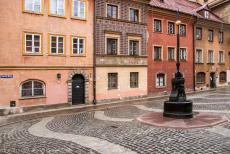
Historic Centre of Warsaw: The Ulica Szeroki Dunaj street in Warsaw almost looks like a small square. The name of the street originates from a no longer existing spring, which rose from this place, the Dunaj. The Ulica Szeroki Dunaj street is situated just behind the city walls and close to the Warsaw Barbican and Rynek Starego Miasta, the Main Market Square. The Historic Centre of Warsaw was inscribed on the UNESCO World Heritage List in 1980.
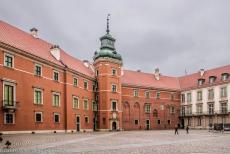
Historic Centre of Warsaw: The Royal Castle was the official residence of the Polish monarchs. In the course of centuries, the Royal Castle in Warsaw was destroyed and rebuilt many times. After the Warsaw Uprising in 1944, the Royal Castle was almost completely destroyed by nazi troops. The decision to rebuild the Royal Castle of Warsaw was taken in 1971. The castle was rebuilt on basis of paintings. The castle was opened to visitors in 1984.

Historic Centre of Warsaw: Dark clouds hovering above the Plac Zamkowy, the Castle Square, in the middle of the square stands the Sigismund's Column, in front of the Royal Castle of Warsaw. The column was erected in 1644 in honour of the Polish King Sigismund III Vasa, who moved the capital city of Poland from Kraków to Warsaw. The tall Sigismund's Column is one of the oldest monuments in Warsaw. The column is a famous meeting point in the historic city.
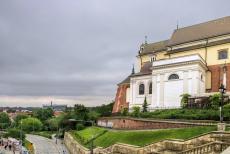
Historic Centre of Warsaw: The Warsaw National Stadium seen from the Old Town. The Warsaw National Stadium (Stadion Narodowy) was built for the UEFA Euro 2012. The Church of St. Anne on the right hand side. The Church of St. Anne is one of the the oldest buildings in Warsaw. The church was slightly damaged during a German air raid in the beginning of WWII in 1939, the roof was later heavily damaged after the Warsaw Uprising in 1944 by nazi-troops.

Historic Centre of Warsaw: The urn containing the heart of the composer and pianist Frédéric Chopin is immured in a pillar of the Church of the Holy Cross in Warsaw. When the Polish-born Chopin died in Paris in 1849, his body was buried in Paris, but his heart was taken to Warsaw, as requested by Chopin on his deathbed. Chopin's heart was sealed in a jar of cognac and brought to Warsaw by his sister. Only after ninety-six years, following several twists, the heart of Chopin was permanently transferred to the Church of the Holy Cross in Warsaw. The church was heavily damaged during WWII, the plaque and urn had been hidden away.
